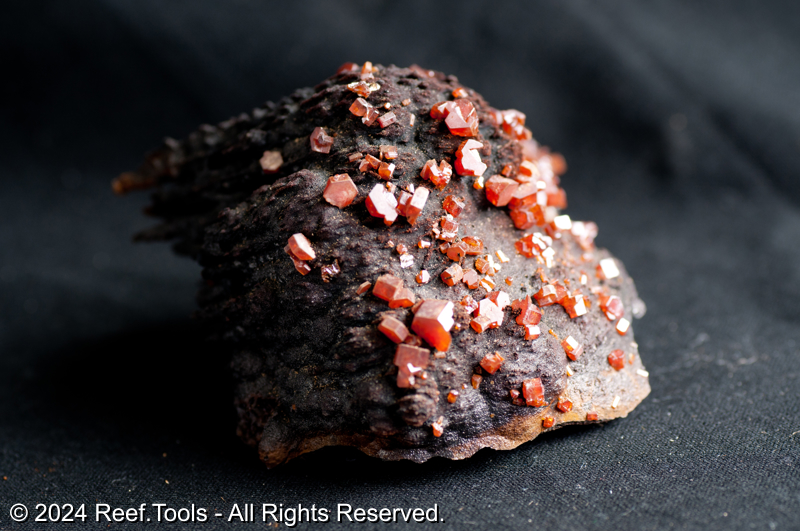Vanadium (V)
Transition Metals
Atomic Number: 23
Last Reviewed: 12/14/2024
Vanadium is a transition metal found in seawater at trace levels. It exists in multiple oxidation states, with vanadate (V₅O₁₄) being the most prevalent in oxygenated marine environments. Its chemical versatility allows it to exist in multiple oxidation states, contributing to complex biogeochemical cycles. While vanadium is a recognized trace element in marine systems, its specific role in reef aquariums and the health of corals remains poorly understood, warranting cautious management.
Natural Seawater Levels
Vanadium concentrations in seawater range from 1.5 to 3 µg/L. These levels are stable due to vanadium's conservative behavior, where its distribution is primarily influenced by ocean circulation rather than biological activity. (Bruland, 1983)
Risks
Deficiency:
- There is no conclusive evidence suggesting vanadium deficiency affects marine organisms or reef aquariums. Its biological role appears limited and non-essential for corals.
Toxicity:
- Elevated vanadium concentrations can disrupt biological processes. Vanadium toxicity arises from its ability to mimic phosphate, potentially interfering with phosphate-dependent enzymes. (Crans et al., 2004)
Relevancy
Biological Roles in Marine Life:
Vanadium is a cofactor in specific enzymes, such as vanadium-dependent nitrogenases found in certain nitrogen-fixing bacteria. These enzymes play a role in nitrogen cycling within marine environments. (Rehder, 1999)
Trace Element in Marine Organisms:
Vanadium has been detected in the tissues of marine organisms, including corals and sponges. Its incorporation appears to be incidental rather than biologically essential. (Wever & Hemrika, 1995)
Potential Role in Coral Pigmentation:
Vanadium may influence coral coloration, but the evidence is anecdotal. Its role in pigmentation is not firmly established in scientific literature.
Ocean Values
| Reference Name | Low | High | Optimal | Unit |
|---|---|---|---|---|
| Red Sea Ocean | 1.0000 | 3.0000 | 2.0000 | µg/L |
| Australia Ocean(Generic) | 1.0000 | 3.0000 | 2.0000 | µg/L |
| Hawaii Ocean | 0.7000 | 3.0000 | 1.7000 | µg/L |
Regional Variations
Vanadium concentrations in seawater are relatively consistent globally, with minor variations influenced by local environmental factors.
Dosage Recommendations
Target Level: Maintain vanadium concentrations at natural seawater levels (~1.5 to 3 µg/L).
Adjustment: Supplementation is not recommended unless part of a controlled experimental setup.
Handling
Testing: Utilize advanced analytical methods (e.g., ICP-MS) for precise measurement if necessary.
Intervention: Supplementation should only occur in experimental contexts or if a depletion is confirmed using reliable data.
Reef.Tools recommends: Maintain Vanadium (V) concentrations between 1.5000 and 3.0000 µg/L.
References
- Rehder, D. (1999). "The Role of Vanadium in Biology." Journal of the American Chemical Society. Oxford
- Wever, R., & Hemrika, W. (1995). "Vanadium Enzymes in Marine Organisms." Annual Review of Biochemistry.
- Bruland, K. W. (1983). "Trace Elements in Seawater." Marine Chemistry.
- Crans, D. C., et al. (2004). "The Chemistry and Biochemistry of Vanadium and Its Role in Biological Systems." Chemical Reviews.
Difficulty
Rating: Easy
Vanadium is naturally maintained within its optimal range in reef aquariums through standard maintenance practices like water changes.
Categorization
Element Type: Transition Metal
Role: Trace Element
Not Usually Deficient
Regular water changes with quality salt mixes typically replenish vanadium, preventing deficiencies.
Not Essential
Vanadium has no known critical biological role in marine organisms, and its incidental incorporation does not suggest biological necessity.
Aliases
V
